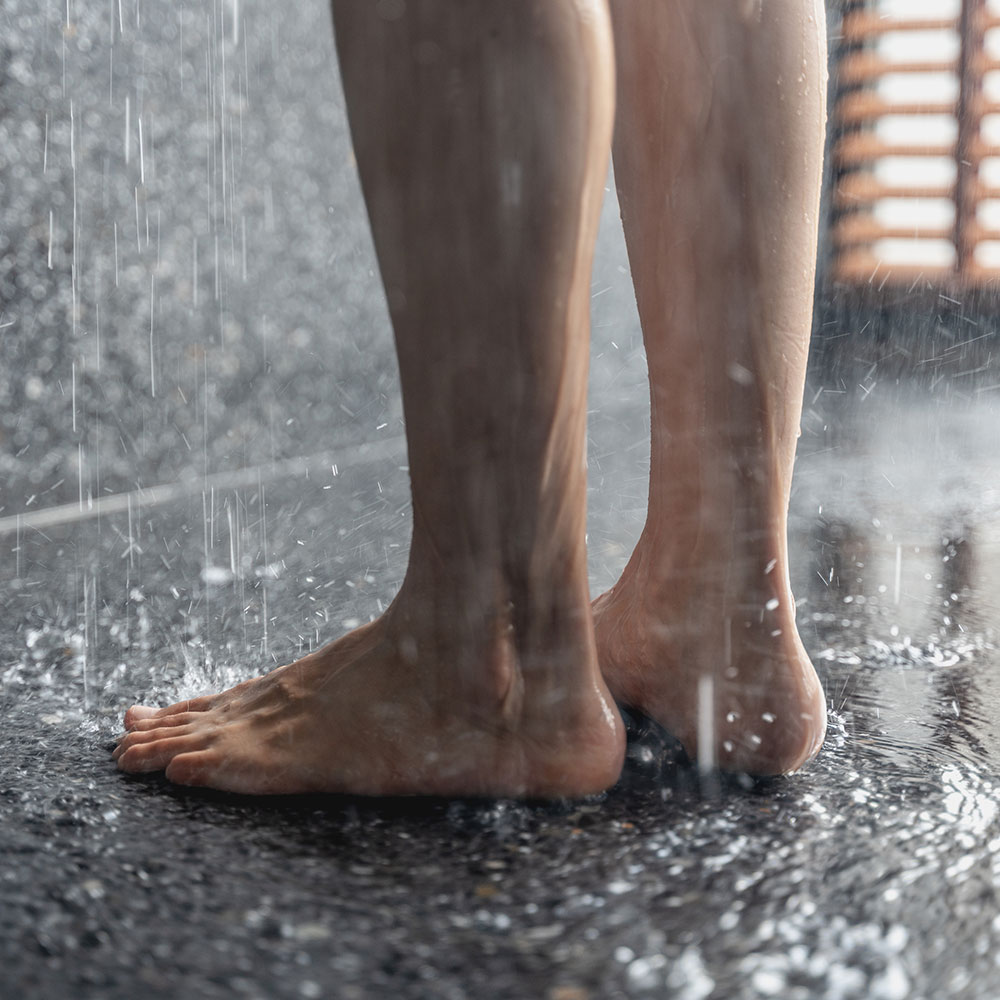
Many clients tell us they want a heated floor in their bathroom. For those of you who haven’t experienced it, you really should try it out! It is fantastic! It elicits a remarkably comforting feeling in the colder months. Think about stepping on a floor surface with the perfect temperature to warm your toes—a little luxury that will surely make you smile. What is involved in achieving this slice of floor warmth heaven? Let’s start with the basics.
Radiant floor heating systems produce heat through thermal radiation. By heating the floor, rather than the surrounding air, these systems provide indirect, diffused heat that radiates from the floor up. This heat is absorbed by surrounding objects (your floors, walls, furniture, and even you!), which help warm the entire room. You feel the direct radiant heat under your feet as well as uniform heat over your whole body, even when the surrounding air temperature is low. In fact, heated floors operate at a lower temperature than a forced air system.
There are two types of systems available: electric and water-based. Electric systems utilize electricity to heat a thin wire or mat located directly below the finished floor (usually tile). Water-based systems circulate warm water through pipes located in the floor framing.
The suitability of each system depends on your project and preference. An electric system is often better for small areas and renovations, while water-based systems are more suited for new construction. This blog post focuses on electric systems with tiled finished floors.
What are the benefits of an electric heated bathroom floor?
- Uniform heating. An electric heated floor system heats the entire floor, providing even heat distribution with no cold spots or drafts.
- Users feel warmer. You’ve likely heard that if you keep your feet warm, the rest of you will feel warm. A heated floor translates to warm feet, and when compared to the heat provided by a traditional forced air system, you will feel warmer even at a lower ambient temperature. This feeling is especially true for spaces with tile and stone floors in the fall, winter, and early spring.
- Fast drying. Heated bathroom floors dry faster than floors without radiant heat, which results in less mold and mildew. (However, you still need to run your bath fan for humidity control! And, squeegee your tile to minimize the bulk water the heated floor and fan have to evaporate.)
- Energy-efficient. Radiant floors distribute heat evenly throughout the room, so there is no need to overheat the space to compensate for cold spots. Additionally, radiant floors do not rely on ductwork that can leak heat.
- Design freedom. Since the components of heated floors are under the tile, no heat registers or radiators muck up the space.
- Space-saving. Radiant floors have no ductwork, which takes up space in floors, ceilings, and vertical chases.
- Easy to install. Radiant floors are easy to install, both in new construction and also in remodels.
- Easy to control. A simple wall-mounted thermostat operates a heated floor.
- No maintenance. With electric heated floors, there is literally nothing to maintain. (This is not true for a water-based heated floor.)
- No noise.
- Non-allergenic. Heated floors do not move air, eliminating the circulation of dust or other allergens.
Are there any drawbacks?
The main drawback to a heated bathroom floor is that it is more expensive than extending your existing heat system (likely forced air) into your bathroom. Although, since heated floors are energy efficient, it will pay itself back over time.
Another item to consider, is that future renovations in the area with the heated floor may be limited, since cutting into the floor can damage the system below.
What are the different types of electric heated bathroom floor systems?
There are two types of heated floor systems available for your bathroom: heat mats or a cable system.
A heat mat system uses a fiberglass mesh with heat cables pre-installed within the mat. While the mesh is cuttable, the heat cables are not, making these systems difficult to install in irregularly shaped or small areas.
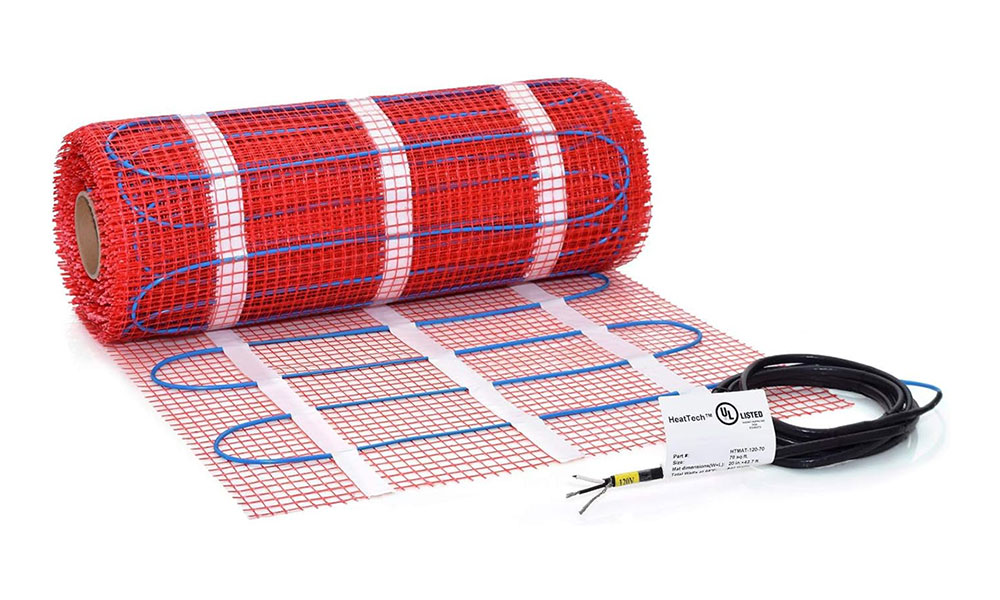
On the other hand, with a cable system, the heat cable is independent of the mat. This allows more flexibility during installation, since both the mat and cable can be cut to any shape and size.
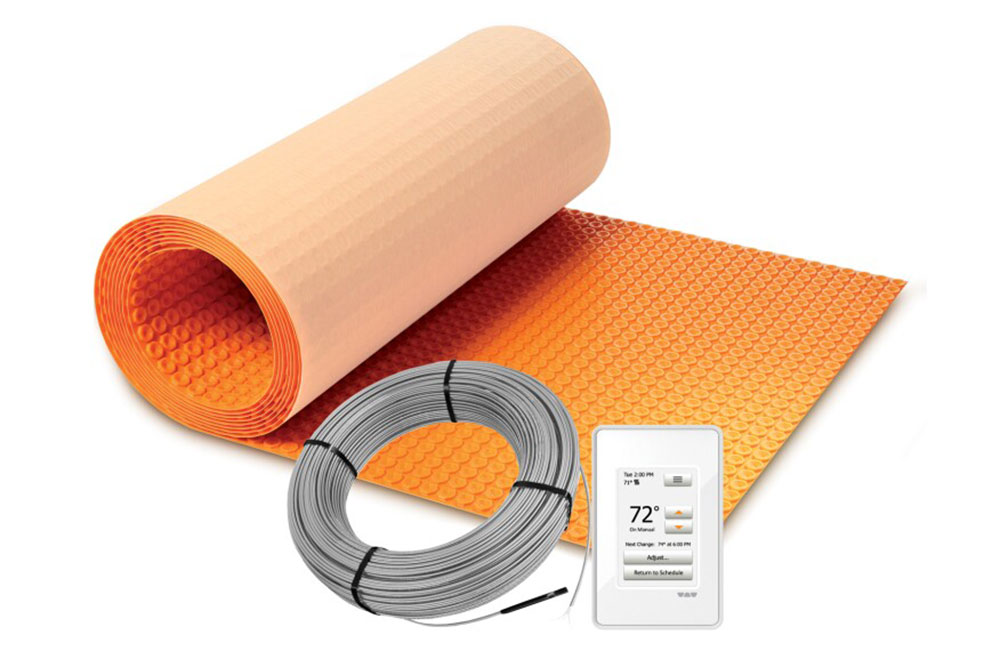
Which is better?
To answer this question, we spoke with Chris Campbell of Campbell’s Tile Concepts. Chris and his crew have installed hundreds of heated bathroom floors, including installations in many of our projects. Campbell’s uses the heat cable system by Schluter. Campbell says, “We prefer the cable system since it provides the most flexibility during installation. We can install them in any shape we want, allowing for total design freedom. They can also be installed in smaller, tighter areas than a heat mat system. Additionally, the cable system has little to no cold spots, whereas heat mats often have cold spots.”
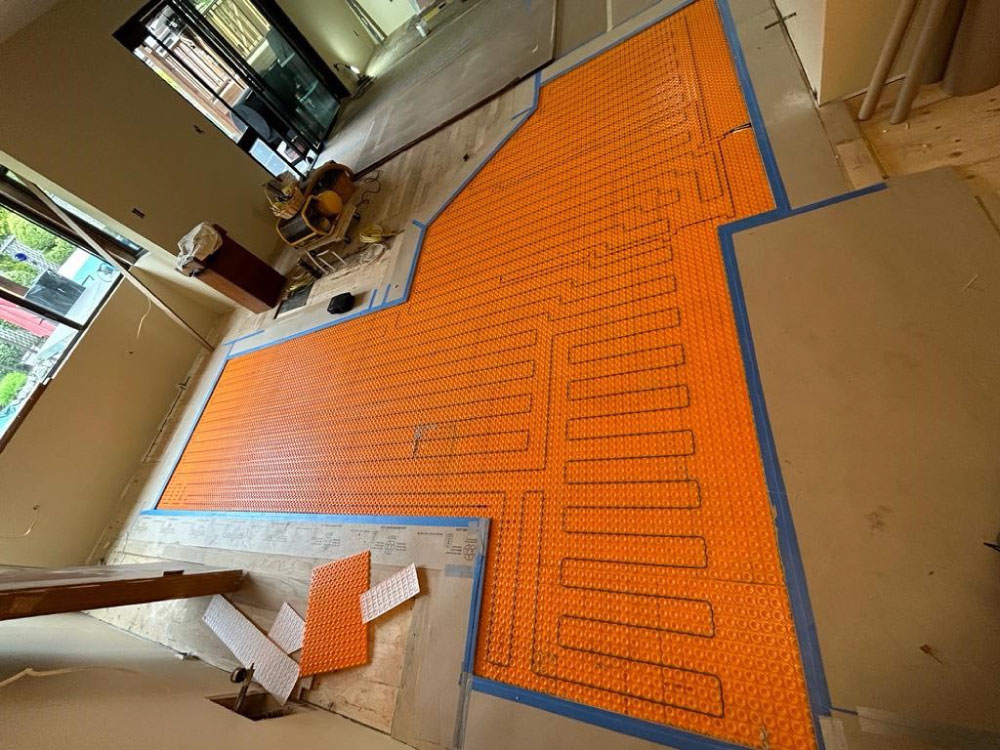
The Schluter product is a system, meaning it includes not only the heat cables, but also the crack isolation membrane, waterproofing, drain, thermostat and other components necessary for the installation. Campbell continues, “The Schluter heat cable system currently has the best warranty on the market, and when used as a system, the warranty covers the entire installation.”
How do I control my heated bathroom floor?
A wall-mounted thermostat controls a heated bathroom floor. A basic model requires the user to turn it on and off manually. However, if you want your floor to turn on before you wake up and turn off during the day when you are not home, a programmable thermostat may be the right choice.
Further, some manufacturers sell wi-fi and smart thermostats, allowing heat control from anywhere in the world. These thermostats often allow third-party integration with voice and home assistants. Campbell states, “This is especially nice for second homes where continuous heat isn’t necessary. The remote access allows homeowners to prep their house when in route, so it is warm upon arrival.”
Can I heat my shower floor too?
Yes, with the cable system the heat cables can continue directly from the bathroom floor into the shower with a single thermostat to control both areas. A heated shower floor not only keeps your toes warm while showering, it also dries the shower floor faster, helping eliminate mold and mildew.
However, it is important to note you cannot have a heated shower floor without heating the bathroom floor. The heat cable needs to start and end in the bathroom floor.
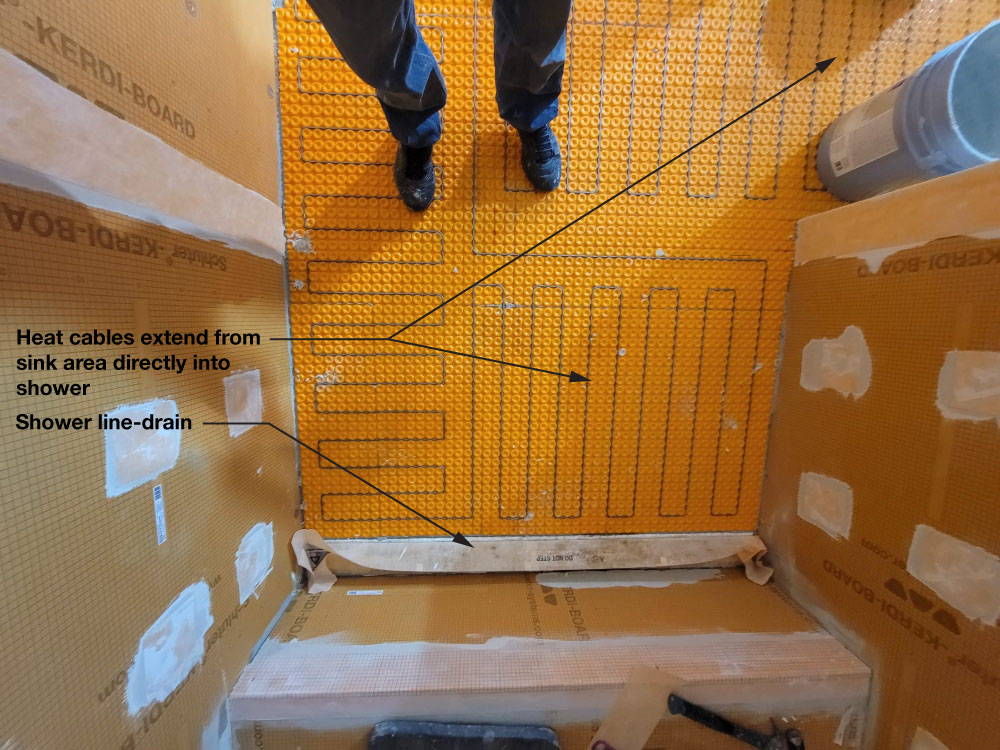
Adding heat to the shower floor works beautifully with a walk-in shower. In our Riverview Mid-Century project pictured below, the heated floor continues directly from the sink and toilet area into the shower.
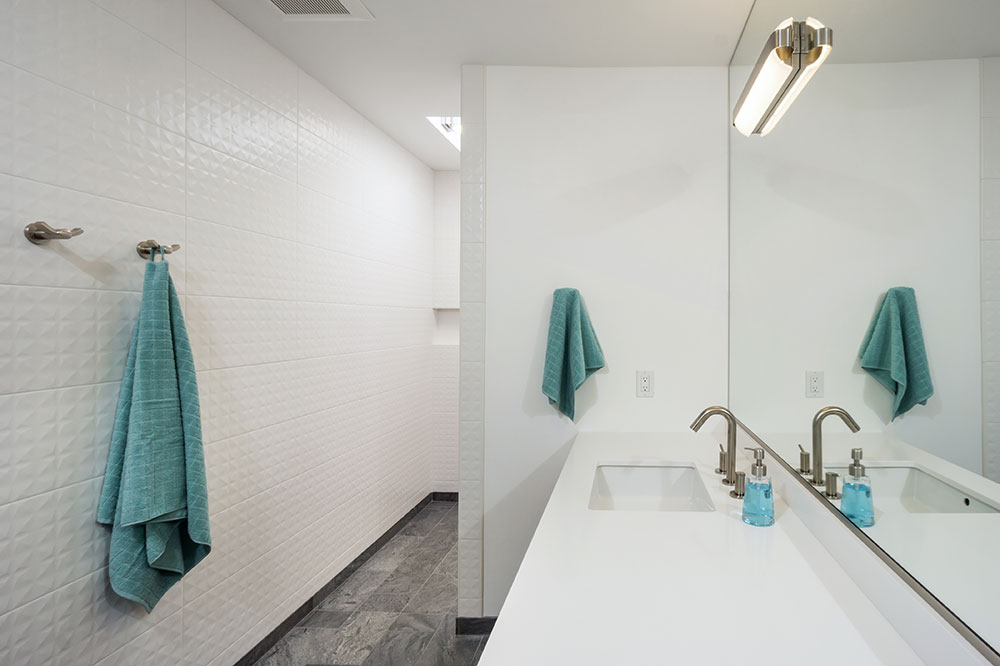
Can the heated bathroom floor system run in a tiled bench?
Yes, by running the cables under the tile in a shower bench, you can heat your “seat” and feet! As long as the bench is solid (not floating), you can heat it.
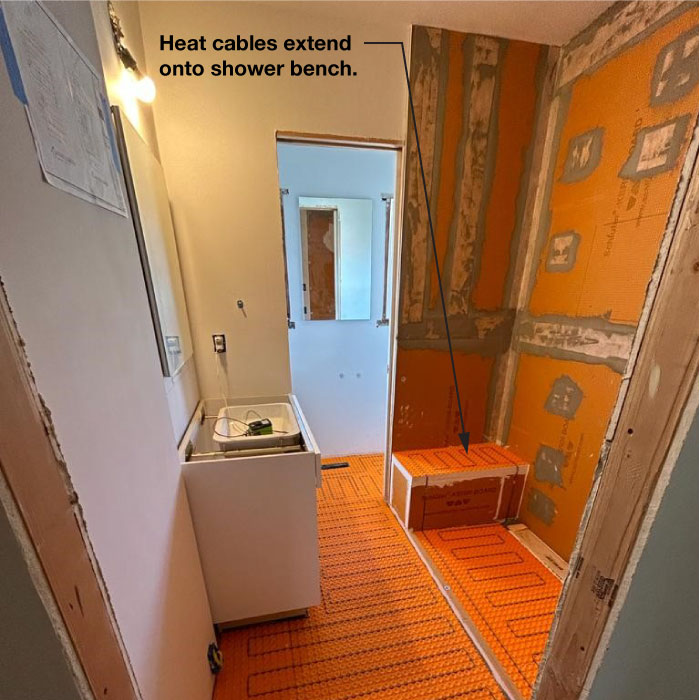
What happens if something breaks with the heated bathroom floor system?! Do I have to rip up the floor to fix it?
According to Campbell’s, “Problems with the Schluter cable system are rare.” However, if needed, Campbell’s can run a diagnostic check to locate any breaks or shorts in the cable below the tile. Campbell states, “The diagnostics isolate exactly where the break is, so you don’t have to rip up the entire floor. Repair includes pulling up the tile in the affected area only, fixing the cable, and resetting the tile. The exception is if there is a break in the cable under the shower. If this happens, the entire shower floor needs to be re-waterproofed and replaced. But again, this is not common.” Campbell suggests keeping a few tiles on hand after completing a bathroom renovation just in case you have to pull one up and need a replacement.
As you can imagine, mat systems are much more difficult to repair, since the cable cannot be cut. Problems with a mat system may require replacing the entire floor.
Can it run up the walls? Would there ever be a need for this?
At this time, Oregon and Washington codes do not allow radiant heat in walls, other than to reach a heated bench. And quite frankly, we don’t see a reason why this would ever be necessary. The beauty of a floor system is that heating the floor is enough to warm the entire room.
Are there other areas that would benefit from a heated floor?
This heating method works in any room with a tile floor. Kitchens, entry halls, mudrooms, laundry rooms, and sunrooms are all ideal locations for a heated floor.
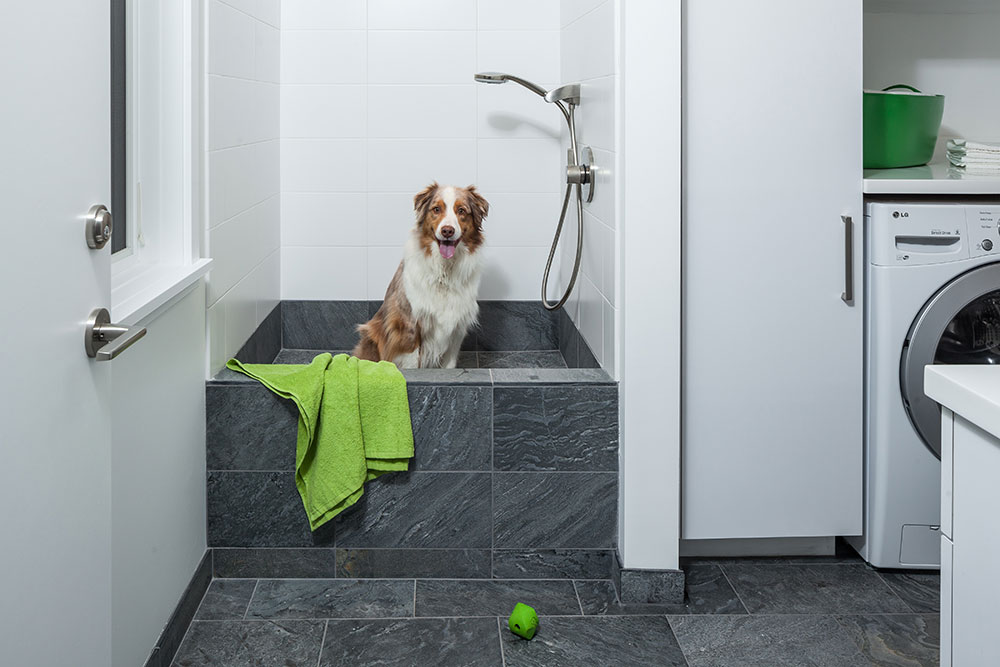
Campbell says, “We have even installed heat on the edges of kitchen islands and bars, where people rest their arms. We don’t install any deeper than 12-inches from the edge, since you don’t want your glass of cold milk on a heated surface!”
Are there conditions where you should NOT use a heated floor system?
Yes, there are a few places where heated floors should not be used or proximity should be considered:
- Heat cables should be kept away from floor-mounted toilets to minimize condensation in the toilet bowl and prevent melting the wax ring.
- Heated floors should not run under cabinetry.
- Maintain space between heated floors and fireplaces or other heat sources.
- Most projects do not heat closets, unless they are large walk-in closets.
- If a closet is heated, the cables should not run under the clothing storage areas.
- Pantries should not have a heated floor.
- Heated floors should not run below areas covered with large area rugs, as this may contribute to system overheating.
- Some area rugs and carpet tiles are not compatible with heated floors, as they may melt. It is important to consult the manufacturer’s specifications for any synthetically-backed carpets you plan to lay on your heated floor.
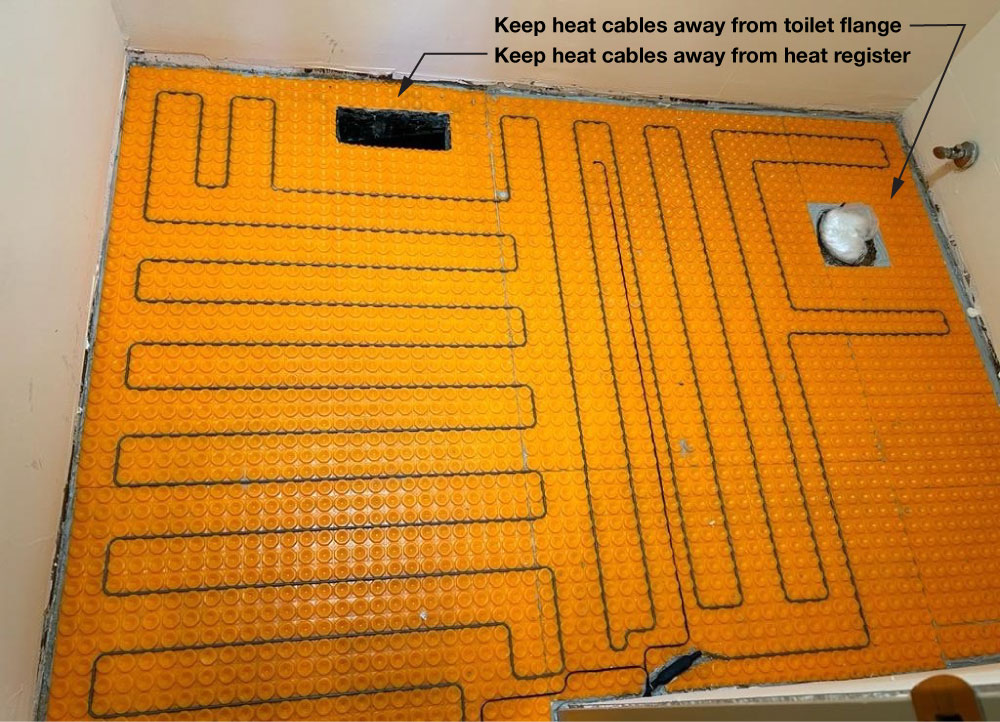
Is there an area limitation?
No, a heated floor can be used in rooms of all sizes, from a tiny powder room to a spacious primary bath. However, a radiant electric cable system is not recommended as the primary heat source for an entire house. (For a whole house radiant heat source, a warm water-based system with a boiler is best. We will cover that in another post.)
Do you want toasty toes?
There is nothing nicer than walking into the bathroom at two in the morning and having the floor comfort your toasty bed-warmed feet! (Or nothing worse than stepping on a cold floor in the middle of the night. It takes time to rewarm ice-cube feet when you get back to bed!) We enjoy this little luxury in our own home. And guess what…the radiant heat even makes the potty seat seem warm!
Give us a call if toasty toes sound like a nice upgrade to your next project.
